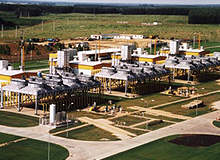
The Yamal–Europe pipeline is a natural gas distribution system running across four countries including Russia, Belarus, Poland and Germany. The 4,107km-long pipeline has a diameter of 1,420mm and can carry 33 billion cubic metres a year. It transports natural gas from the Yamal peninsula to European consumers.
Construction commenced in 1994 and the pipeline was fully commissioned in 2006. The total cost was estimated at $36bn.
Construction and infrastructure
Construction was carried out by dividing the length of the pipeline into different sections.
The 402km Russian segment starts from the Torzhok gas transmission hub in Tver Oblast. This section receives gas from the Northern Tyumen Regions (SRTO)–Torzhok gas pipeline. It features compressor stations at Rzhevskaya, Kholm-Zhirkovskaya and Smolenskaya.
The 575km Belarusian section runs across Belarus and includes five compression stations, at Nesvizhskaya, Krupskaya, Slonimskaya, Minskaya and Orshanskaya. It passes through 199.6km of bogs, 75 river crossings, 10 railways lines and three power transmission networks.
The Polish section is 683km-long and passes through 32 railway lines, 246 roads, 108 surface water streams and seven large rivers. A unique method called microtunneling was used during construction of the section. About 1.3m m³ of earth was removed during its construction.
This section also includes five compressor stations at Ciechanow, Szamotuly, Zambrow, Wloclawek and Kondratki. The stations have a total driving power of 600MW and feature four to six turbocompressor units driven by a 25MW gas turbine.
It is equipped with 33 valve stations featuring cut-off valve systems. The valves enable parts of the pipeline to be shut down between the stations. They also enable flow diversion from another line reducing capacity loss.
The German section is connected to the YAGAL-Nord gas transmission system which is in turn connected to the STEGAL–MIDAL–Rehden UGS gas transmission system.
Technology
The Polish section features a dedicated Alcatel communication system, which ensures safe and effective operation of the pipeline. The system consists of fibre optic circuits connected to 155Mbit/s SDH devices. All the compression stations and other facilities of the section are connected to the fibre optic circuits of the communication system, enabling the operators to monitor the pipeline.
A SCADA system is also installed in the Polish section. It helps to continuously monitor the pipeline, compressor stations and other facilities. In case of emergency, the system generates alarms to alert the operators. The SCADA system was provided by ALSTOM / CEGELEC.
The Polish section is further equipped with conventional metering technology featuring orifice meters. This technology had several disadvantages such as high-pressure calibration and constant maintenance.
In 2008, EuRoPol GAZ contracted SICK MAIHAK to install the FLOWSIC600 ultrasonic meter at the Kondratki compressor station. The FLOWSIC600 ultrasonic meter was more precise and reduced inaccuracy to the minimum.
Contractors
Construction of the German part of the pipeline was carried out by WINGAS, a joint venture between Gazprom and Wintershall. Gazprom was solely responsible for construction of the Belarusian segment.
Stroytransgaz was the general contractor for the section between Russia and Belarus.
EuRoPol GAZ, a joint venture between Gazprom and PGNiG, was responsible for the Polish segment. Design services were supplied by Gazoprojekt. Construction contractors included GAZ-2000, MegaGaz, BUG Gazobudowa and Naftowo–Gazowe Przedsiebiorstwo Budowlano-Montazowe Karpaty.
ABB was awarded a $96m contract in July 2004 for the construction of Zambrow compression station in the Polish section. The company was also awarded a $190m contract in 2004 for construction of two compressor stations at Szamotuly and Ciechanow.
Pressure tests were carried out by Pipetronix.



